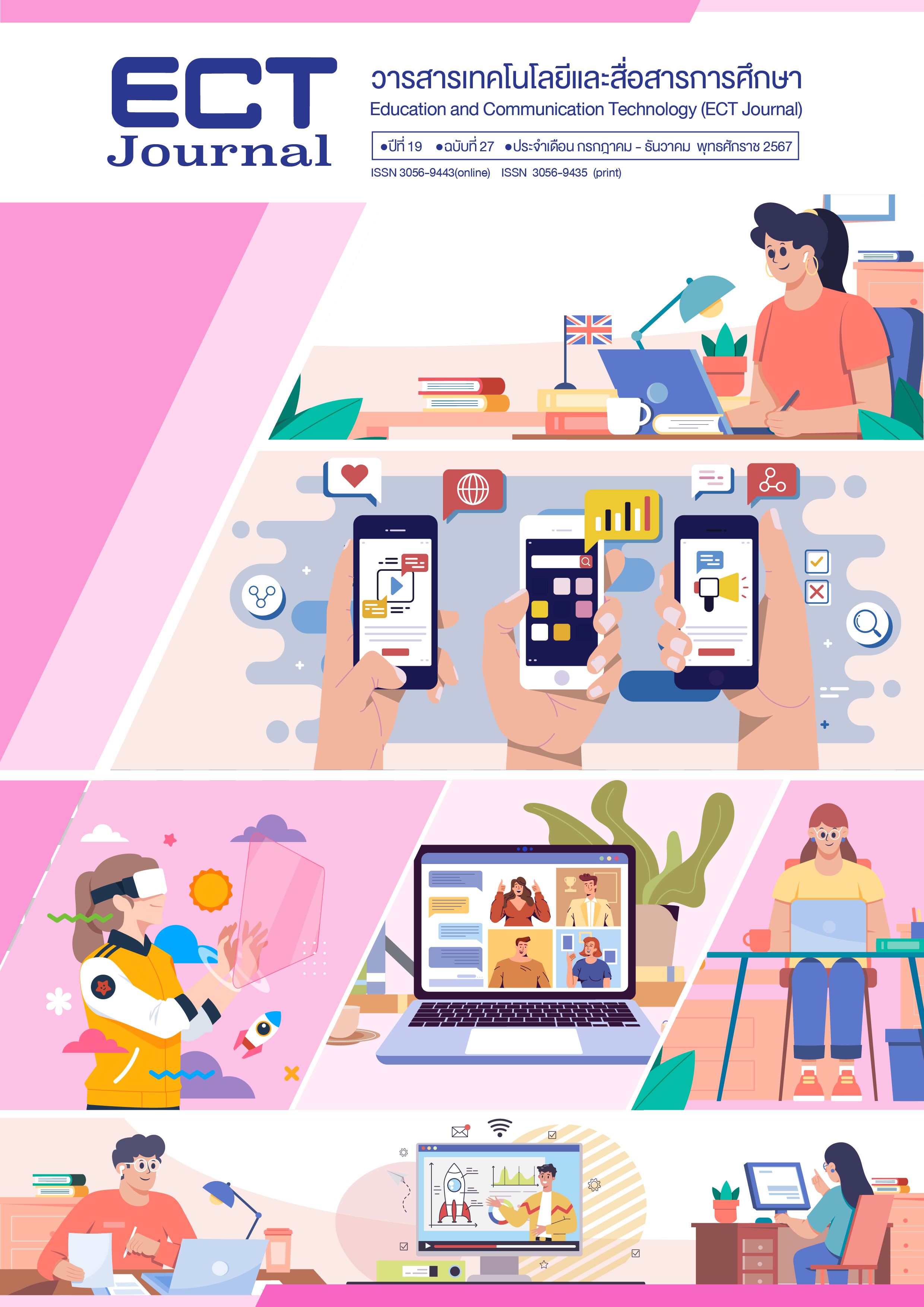A Development of Micro Learning to Strengthen the Ability to Use Foreign Language Words in Thai for Grade 6 Students
Keywords:
micro learning, the ability to use foreign languages in ThaiAbstract
The objectives of this research article were: 1) to construct and verify the efficiency of micro learning in strengthening the ability to use foreign words in Thai for grade 6 students based on the 80/80 criteria, 2) to compare the ability to use foreign words in Thai among grade 6 students before and after studying with micro learning, and 3) to study the students' satisfaction with micro learning. The research model employed in this study was research and development. The sample group consisted of 15 grade 6 students from the second semester of the academic year 2021 at Banpongpa School in Phitsanulok, selected by purposive sampling. The research tools included: 1) micro learning materials to strengthen the ability to use foreign language words in Thai, 2) a test to measure the ability to use foreign words in Thai, and 3) a satisfaction questionnaire. Data were analyzed using percentage, mean, standard deviation, and Z-test. The results of the research were as follows: 1) The micro learning materials developed to enhance the ability to use foreign words in Thai for grade 6 students were highly appropriate (M = 4.51, SD = 0.46) and met the efficiency criteria (83.67/82.10). 2) The ability of students to use foreign words in Thai significantly improved after studying through the micro learning materials (p < 0.05). 3) The students' satisfaction with the micro learning materials was at the highest level (M = 4.72, SD = 0.45).
References
กระทรวงศึกษาธิการ. (2545). หนังสืออุเทศภาษาไทย ชุด บรรทัดฐานภาษาไทยเล่ม 1: ระบบเสียง อักษรไทย การอ่านคำและการเขียนสะกดคำ. คุรุสภาลาดพร้าว.
กาญจนา นาคสกุล. (2555). ภาษาไทย ภาษาธรรม. สมาคมครูภาษาไทยแห่งประเทศไทย.
กันทริน รักษ์สาคร, และคณะ. (2558). รายงานการวิจัย เรื่อง ปัญหาการใช้คำยืมจากภาษาอังกฤษในบริบทไทยและแนวทางการแก้ปัญหา: กรณีศึกษาคณะศิลปศาสตร์ มหาวิทยาลัยเทคโนโลยีราชมงคลศรีวิชัย. มหาวิทยาลัยเทคโนโลยีราชมงคลศรีวิชัย.
ธารีย์ณิชา ลีพีรวิทิตกว้าน, สีตะธนี, และวิเชียร ชุติมาสกุล. (2560). การเพิ่มประสิทธิผลการเรียนรู้ของเจนเนอเรชันแซดผ่านการเรียนรู้แบบไมโคร. ใน การประชุมทางวิชาการระดับชาติด้านคอมพิวเตอร์และเทคโนโลยีสารสนเทศ ครั้งที่ 13. (น. 57). มหาวิทยาลัยเทคโนโลยีพระจอมเกล้าพระนครเหนือ.
ปรัชญนันท์ นิลสุข. (2561). การจัดการเรียนรู้แบบจุลภาค. คณะครุศาสตร์อุตสาหกรรม มหาวิทยาลัยเทคโนโลยีพระจอมเกล้าพระนครเหนือ.
ลัดดาวัลย์ คงสมบูรณ์. (2562). การพัฒนาไมโครเลิร์นนิง สำหรับนักศึกษาระดับประกาศนียบัตรวิชาชีพชั้นสูง วิทยาลัยอาชีวศึกษาเอกชนในเขตกรุงเทพมหานคร. วารสารวิชาการ มหาวิทยาลัยกรุงเทพธนบุรี, 8(2), 51-62.
วรวรรธน์ ศรียาภัย. (2556). ภาษาศาสตร์ภาษาไทย (พิมพ์ครั้งที่ 2). สัมปชัญญะ.
วิไลศักดิ์ กิ่งคำ. (2556). ภาษาต่างประเทศในภาษาไทย (พิมพ์ครั้งที่ 2). สำนักพิมพ์มหาวิทยาลัยเกษตรศาสตร์.
วิสิฐ ตั้งสถิตกุล. (2563). แนวคิดไมโครเลิร์นนิง (Microlearning) กับการเล่าเรื่องข้ามสื่อในยุคดิจิทัล (Cross Media) สำหรับการจัดการเรียนการสอนและผลิตสื่อการสอนในรูปแบบออนไลน์. วารสารพัฒนาข้าราชการ กทม., 5(1), 10-15.
ศยามน อินสะอาด. (2561). การออกแบบ e-learning เพื่อพัฒนาทักษะการคิดขั้นสูง. ซีเอ็ดยูเคชั่น.
สรลักษณ์ ลีลา. (2562). การพัฒนารูปแบบการจัดการเรียนรู้แบบจุลภาคด้วยหนังสือมีชีวิตเพื่อส่งเสริมการคิดเชิงประมวลผล. ใน การประชุมวิชาการระดับนานาชาติสารสนเทศศาสตร์วิชาการ 2019. (น. 1-11). สำนักวิชาสารสนเทศศาสตร์ มหาวิทยาลัยวลัยลักษณ์.
Aitchanov, S. (2013). Training magazine: Bite-size is the right size - How to maximize performance in a society with short attention spans. https://trainingmag.com/content/bite-size-right-size
Bridge Learning Solutions. (2016, April 26). Micro-Learning การเรียนรู้แบบทีละเล็กทีละน้อย. https://www.bridgelearningsolutions.com/16881072/micro-Learning
Davis, Y. (2021). Bite-sized learning vs. microlearning: Are they one and the same. https://elearningindustry.com/bite-sized-learning-vs-micro-learning-are-same
Likert, R. (1967). The method of constructing and attitude scale. In M. Fishbeic (Ed.), Reading in attitude theory and measurement. Wiley & Son.
Nikou, S. A. (2018). Mobile-based micro-learning and assessment: Impact on learning performance and motivation of high school students. Journal of Computer Assisted Learning, 34(3), 269-278. https://doi.org/10.1111/jcal.12240
Simons, L. P. A., Foerster, F., Bruck, P. A., Motiwalla, L., & Jonker, C. M. (2015). Microlearning mApp raises health competence: Hybrid service design. Health and Technology, 5(1), 35-43. https://doi.org/10.1007/s12553-015-0095-1
Downloads
Published
How to Cite
Issue
Section
License
Copyright (c) 2024 มหาวิทยาลัยสุโขทัยธรรมาธิราช

This work is licensed under a Creative Commons Attribution-NonCommercial-NoDerivatives 4.0 International License.
1. ทรรศนะและข้อคิดเห็นใด ๆ ที่ปรากฏอยู่ในวารสาร ECT Education and Communication Technology Journal เป็นของผู้เขียนโดยเฉพาะ สำนักเทคโนโลยีการศึกษา มหาวิทยาลัยสุโขทัยธรรมาธิราช และกองบรรณาธิการไม่จำเป็นต้องเห็นพ้องด้วย
2. กองบรรณาธิการของสงวนลิขสิทธิ์ในการบรรณาธิการข้อเขียนทุกชิ้น เพื่อความเหมาะสมในการจัดพิมพ์เผยแพร่






